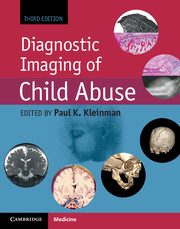Book contents
- Frontmatter
- Dedication
- Contents
- List of Contributors
- Editor’s note on the Foreword to the third edition
- Foreword to the third edition
- Foreword to the second edition
- Foreword to the first edition
- Preface
- Acknowledgments
- List of acronyms
- Introduction
- Section I Skeletal trauma
- Section II Abusive head and spinal trauma
- Section III Visceral trauma and miscellaneous abuse and neglect
- Chapter 22 Visceral trauma
- Chapter 23 Miscellaneous forms of abuse and neglect
- Section IV Diagnostic imaging of abuse in societal context
- Section V Technical considerations and dosimetry
- Index
- References
Chapter 22 - Visceral trauma
from Section III - Visceral trauma and miscellaneous abuse and neglect
Published online by Cambridge University Press: 05 September 2015
- Frontmatter
- Dedication
- Contents
- List of Contributors
- Editor’s note on the Foreword to the third edition
- Foreword to the third edition
- Foreword to the second edition
- Foreword to the first edition
- Preface
- Acknowledgments
- List of acronyms
- Introduction
- Section I Skeletal trauma
- Section II Abusive head and spinal trauma
- Section III Visceral trauma and miscellaneous abuse and neglect
- Chapter 22 Visceral trauma
- Chapter 23 Miscellaneous forms of abuse and neglect
- Section IV Diagnostic imaging of abuse in societal context
- Section V Technical considerations and dosimetry
- Index
- References
Summary
Introduction
Visceral injuries are uncommon but important manifestations of child abuse. Great attention has been given to classic abusive visceral injuries over the years with several recent excellent reviews (1–7). However, the varied and often dramatic clinical and imaging features of inflicted visceral injury remain underappreciated, leading to delayed diagnosis and poor outcome.
Inflicted visceral injury is infrequent compared with the classic skeletal and brain injuries associated with abuse. The average age for fatal visceral injury in abuse is two years (8). Although most injuries occur in ambulatory children, visceral trauma in infants is by no means rare (9, 10). The abdominal organs are more vulnerable to blunt injury in the young child because the abdominal wall musculature is less well developed and increased compliance of the ribs allows increased transmission of forces to underlying structures (11). Injuries to the liver, mesentery, small bowel, and pancreas predominate in this setting, and with state-of-the-art computed tomography (CT), there is better recognition of these injuries.
Early reports of abdominal injuries in abused children focused on injuries requiring surgery or those leading to death. Perry and Venters reported 99 children dying from violence over a 5-year period in Saint Paul and Ramsey County, Minnesota (12). Twelve of these cases were deemed homicides, and seven were believed likely to represent examples of the battered child syndrome. Four of the seven children died from abdominal visceral injury. Only two died from head injury.
- Type
- Chapter
- Information
- Diagnostic Imaging of Child Abuse , pp. 563 - 607Publisher: Cambridge University PressPrint publication year: 2015



